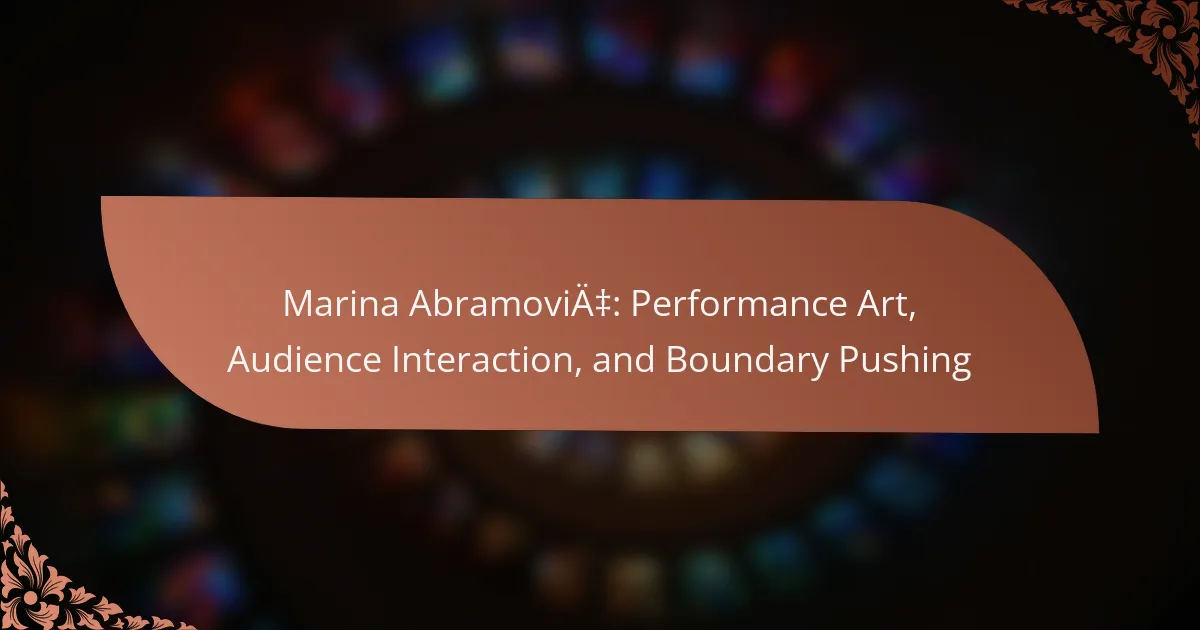Marina Abramović’s performance art challenges conventional boundaries through immersive audience interaction and emotional endurance. Her work emphasizes vulnerability and transforms the relationship between artist and observer. Key performances like “The Artist is Present” and “Rhythm 0” exemplify her unique approach, inviting viewers to confront their limits and engage in a shared experience. This article explores her defining themes, iconic works, and the lessons her approach offers for contemporary art.
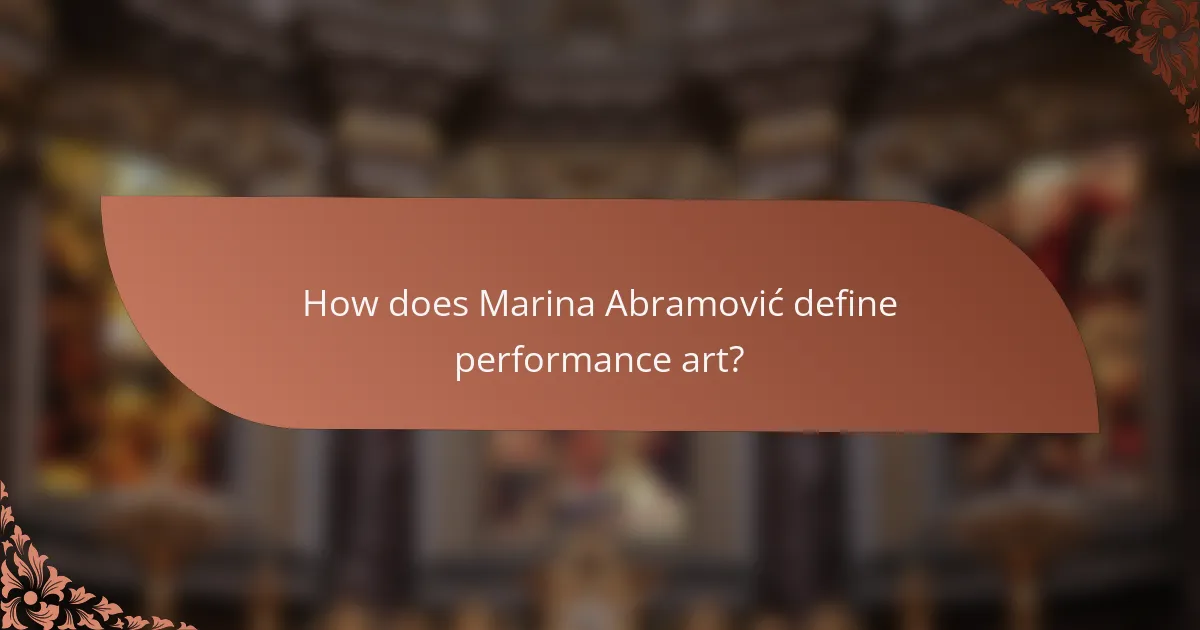
How does Marina Abramović define performance art?
Marina Abramović defines performance art as a live, interactive experience that transforms the relationship between the artist and the audience. Her work often challenges physical and emotional boundaries, emphasizing endurance and vulnerability. Abramović’s performances invite active participation, blurring the lines between artist and observer. This unique approach fosters a deeper connection and reflection on the nature of art itself.
What are the key characteristics of her performances?
Marina Abramović’s performances are characterized by intense audience interaction, emotional vulnerability, and boundary-pushing concepts. She often explores themes of endurance, trust, and the relationship between performer and spectator. Unique attributes include her use of the body as a medium and the incorporation of ritualistic elements. Rarely, her work challenges societal norms and perceptions of art, making each performance a transformative experience for participants.
How has her approach evolved over time?
Marina Abramović’s approach has evolved to emphasize deeper audience engagement and emotional vulnerability. Initially, her performances focused on physical endurance and personal boundaries. Over time, she integrated interactive elements, inviting audiences to participate actively. This shift transformed her work into a shared experience, fostering a profound connection between the performer and the audience. Unique attributes, such as her use of silence and stillness, have become hallmarks of her later performances, challenging viewers to confront their own emotions.
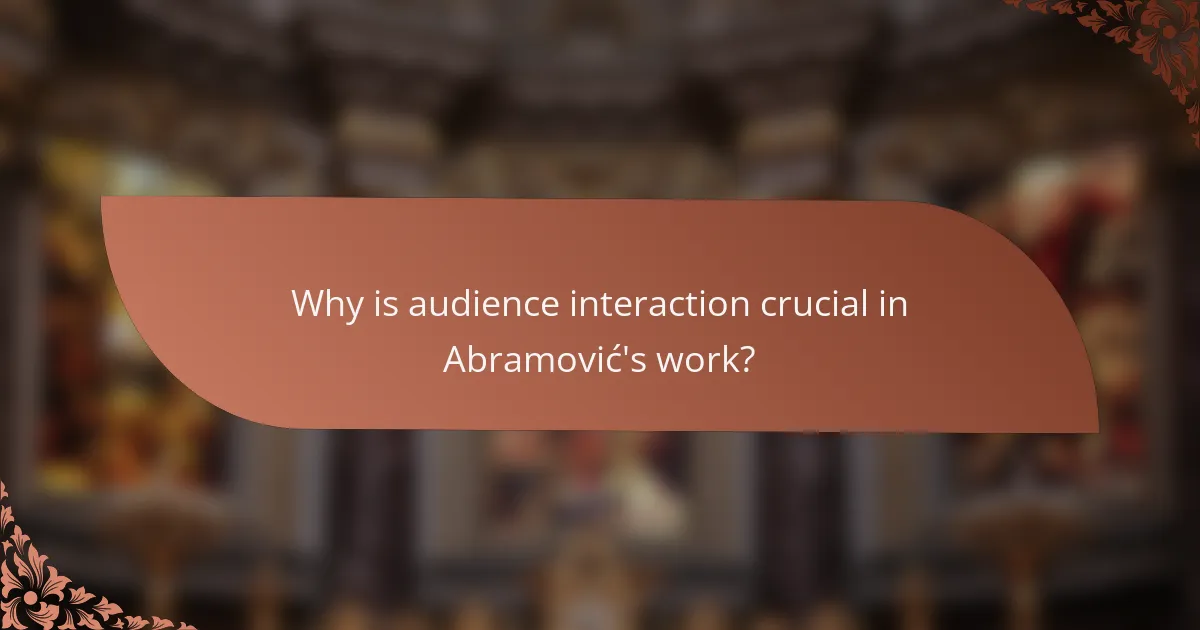
Why is audience interaction crucial in Abramović’s work?
Audience interaction is crucial in Abramović’s work because it transforms the performance into a shared experience. This engagement fosters emotional connections, challenges boundaries, and invites vulnerability. By involving the audience, Abramović creates a dynamic dialogue that enhances the impact of her art. This unique attribute of her performances allows participants to confront their own limits and perceptions, making each event a distinct exploration of human connection and endurance.
What techniques does she use to engage her audience?
Marina Abramović engages her audience through immersive experiences, emotional vulnerability, and physical endurance. She invites participation, creating a shared space that blurs the line between performer and spectator. Techniques like eye contact and silence foster deep connections, enhancing audience involvement. Her unique approach challenges boundaries, encouraging introspection and dialogue.
How does audience participation affect the performance experience?
Audience participation significantly enhances the performance experience by fostering emotional connections and engagement. In Marina Abramović’s work, audience interaction serves as a vital component that transforms passive spectators into active participants. This dynamic shifts the traditional boundaries of performance art, allowing for a shared experience that deepens the impact of the artwork.
Through direct involvement, participants often confront their own emotions and boundaries, which can lead to profound personal revelations. For instance, Abramović’s piece “The Artist is Present” exemplifies this unique attribute of her work, as it invites viewers to sit silently opposite her, creating an intimate exchange that transcends conventional art viewing.
As a result, the performance becomes a collaborative dialogue, where the audience’s presence and responses shape the unfolding narrative. This interplay not only enhances the artistic experience but also challenges societal norms around art and engagement, making each performance a unique event defined by the collective energy of those present.
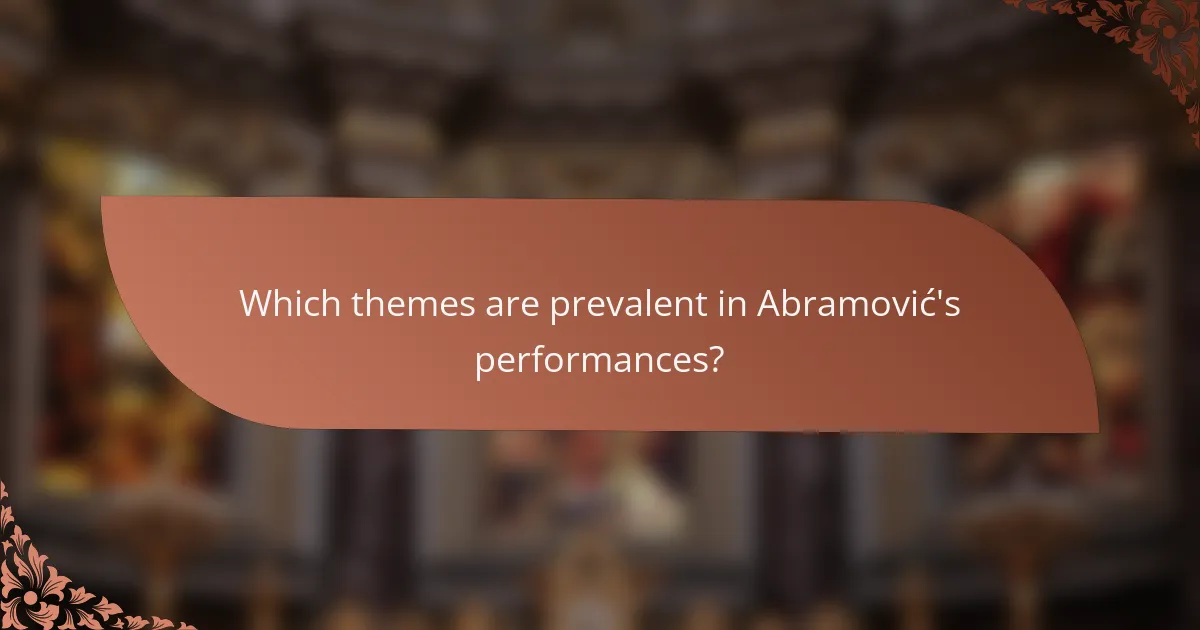
Which themes are prevalent in Abramović’s performances?
Marina Abramović’s performances often explore themes of endurance, vulnerability, and the relationship between artist and audience. She emphasizes physical and emotional boundaries, inviting viewers to confront their own limits. The interplay of time and space is significant, as seen in her long-duration pieces. Additionally, her work frequently addresses concepts of ritual and transformation, pushing the boundaries of traditional performance art.
How does she explore concepts of endurance and vulnerability?
Marina Abramović explores concepts of endurance and vulnerability through immersive performance art that challenges both her physical limits and audience perceptions. Her work often involves prolonged physical exertion, inviting spectators to confront their own discomfort and emotional responses. For instance, in “The Artist Is Present,” she maintained a silent, seated presence for over 700 hours, emphasizing the endurance of both body and spirit. This unique approach fosters a deep connection between artist and audience, revealing the rawness of human experience. Abramović’s performances serve as a powerful commentary on the nature of vulnerability, pushing boundaries to elicit profound introspection.
What role does the body play in her artistic expression?
The body plays a crucial role in Marina Abramović’s artistic expression by serving as a medium for vulnerability and endurance. Through physicality, she engages the audience, creating a direct emotional connection. Her performances often challenge the limits of the body, exploring themes of pain, intimacy, and human interaction. This embodiment of art allows her to push boundaries, transforming the audience’s experience from passive observation to active participation.
![]()
What are some of the most iconic performances by Marina Abramović?
Marina Abramović’s most iconic performances include “The Artist is Present,” “Rhythm 0,” and “Balkan Baroque.” Each work exemplifies her commitment to audience interaction and emotional endurance.
“The Artist is Present” at MoMA in 2010 featured Abramović sitting silently across from visitors for 736 hours, creating a profound connection. “Rhythm 0” in 1974 challenged boundaries by allowing the audience to use various objects on her body, highlighting vulnerability. “Balkan Baroque,” awarded the Golden Lion at the Venice Biennale in 1997, focused on the themes of war and cleansing through a powerful ritual involving washing bones.
These performances showcase her unique ability to engage the audience and push the limits of performance art.
How did “The Artist Is Present” challenge traditional boundaries?
Marina Abramović’s “The Artist Is Present” challenged traditional boundaries by redefining audience participation in performance art. The work blurred the line between artist and viewer, transforming passive observation into active engagement. This interaction fostered intimacy and vulnerability, compelling participants to confront their emotions. Abramović’s unique approach emphasized the power of presence, creating a shared experience that transcended conventional art forms. This radical shift has influenced contemporary performance art, inspiring artists to explore deeper connections with their audiences.
What impact did “Rhythm 0” have on audience perception?
“Rhythm 0” significantly altered audience perception by challenging boundaries of participation and responsibility. The performance invited observers to engage with objects that could inflict harm, prompting reflection on human behavior and ethics. This interaction transformed spectators into active participants, revealing their moral choices. As a result, “Rhythm 0” became a pivotal moment in performance art, demonstrating the power of vulnerability and the impact of audience dynamics.
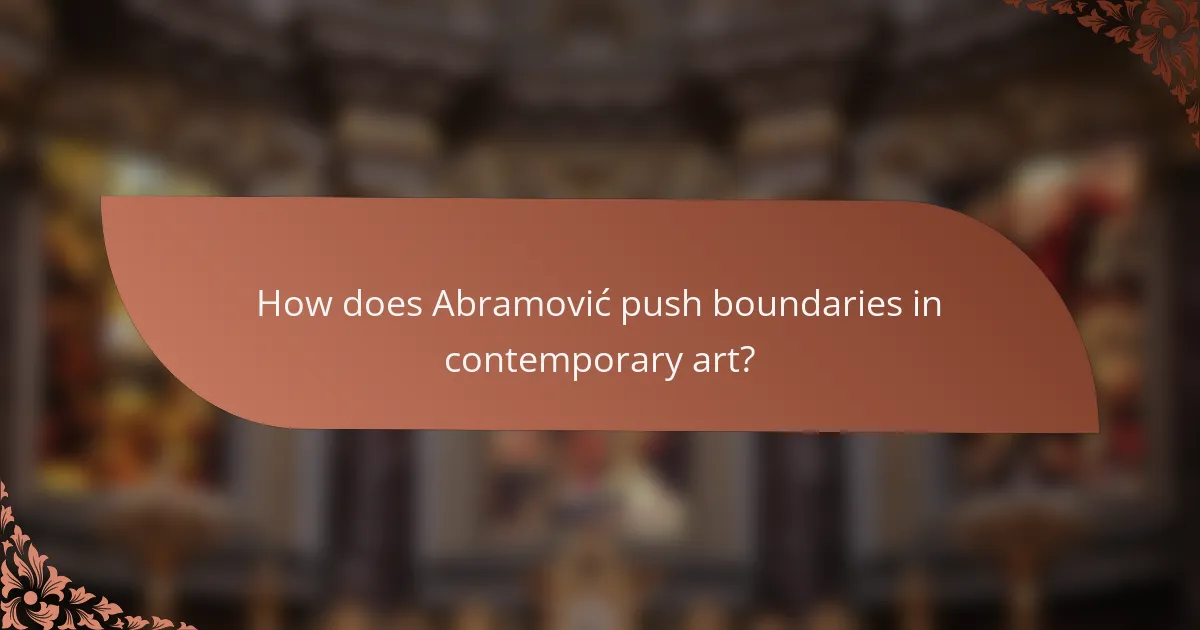
How does Abramović push boundaries in contemporary art?
Marina Abramović pushes boundaries in contemporary art through immersive performance and profound audience engagement. Her work often challenges perceptions of time, endurance, and vulnerability. By inviting viewers to participate actively, she transforms the spectator into a co-creator, blurring the lines between artist and audience. This unique approach fosters intense emotional experiences, prompting reflection on personal and collective boundaries. Through pieces like “The Artist is Present,” she explores themes of presence and connection, redefining the role of art in society.
What risks does she take in her performances?
Marina Abramović takes significant risks in her performances, including physical endurance, emotional exposure, and audience engagement. She often subjects herself to pain and vulnerability, which challenges both her and the audience’s boundaries. Her unique approach can lead to unpredictable interactions, heightening the intensity of the experience. Additionally, she risks public perception, as her provocative art may be misunderstood or criticized.
How does she challenge societal norms through her art?
Marina Abramović challenges societal norms through her art by confronting audiences with intense emotional experiences. Her performances often involve vulnerability, endurance, and direct engagement, prompting viewers to reflect on their own boundaries. For example, in “The Artist Is Present,” she invited participants to sit silently across from her, breaking the barrier between performer and audience. This interaction questioned the nature of presence and connection in a digital age. Abramović’s unique approach pushes the limits of performance art, encouraging discourse on identity, power, and societal expectations.
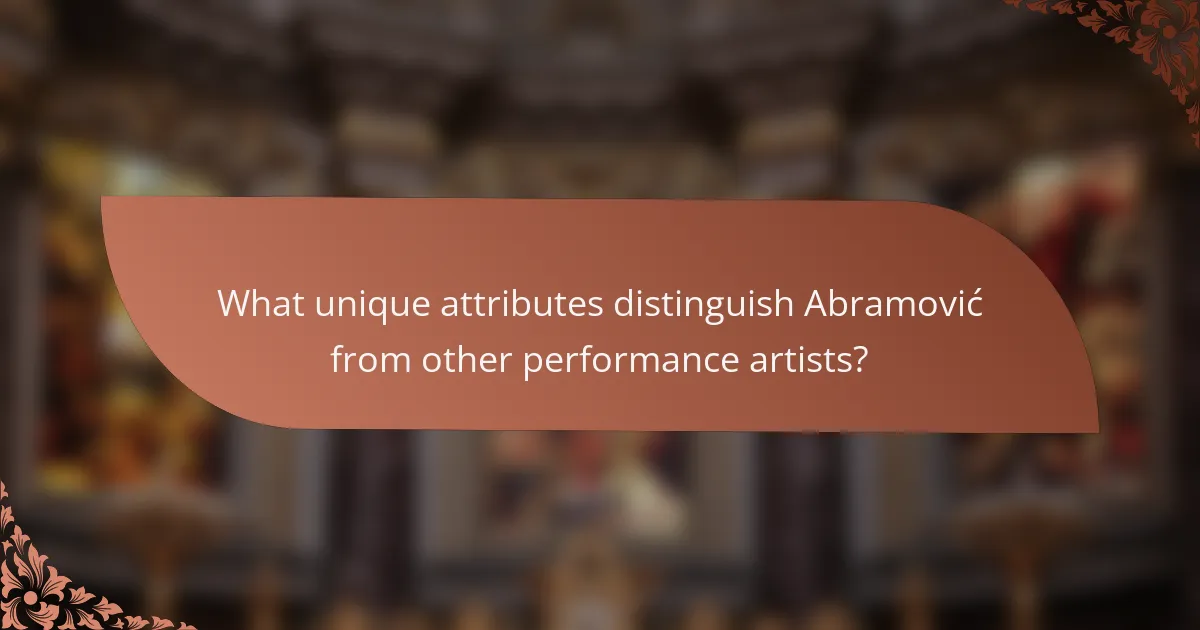
What unique attributes distinguish Abramović from other performance artists?
Marina Abramović is distinguished from other performance artists by her unique approach to audience interaction and her commitment to pushing physical and emotional boundaries. Her performances often involve prolonged durations, intense physical challenges, and a focus on the relationship between artist and audience. This immersive engagement creates a transformative experience for participants, setting her apart in the performance art landscape. Abramović’s unique attribute of using her own body as a medium for exploration and expression further emphasizes her distinctiveness.
How does her cultural background influence her work?
Marina Abramović’s cultural background profoundly shapes her work, emphasizing themes of endurance and vulnerability. Growing up in Yugoslavia, she experienced a strict upbringing that instilled discipline and a strong sense of identity. This background influences her exploration of human relationships and the audience’s role in performance art.
Her performances often reflect the tension between personal history and collective memory, inviting audiences to confront their own experiences. For instance, in “The Artist is Present,” she engaged with viewers on a deeply personal level, fostering a connection that transcended traditional boundaries. This unique approach highlights the impact of her cultural roots on her artistic expression.
Additionally, Abramović’s commitment to challenging societal norms stems from her heritage, pushing the boundaries of art and questioning the nature of performance itself. Her work serves as a bridge between individual and cultural narratives, enriching the landscape of contemporary art.
What personal experiences shape her artistic vision?
Marina Abramović’s artistic vision is shaped by her personal experiences of endurance, trauma, and cultural heritage. Her childhood in a strict Yugoslavian family instilled discipline and a deep understanding of pain. The performance “Rhythm 0” exemplifies her exploration of audience interaction and vulnerability, showcasing her unique ability to push boundaries. Additionally, her travels and encounters with diverse cultures have enriched her perspective, allowing her to redefine the relationship between performer and audience.
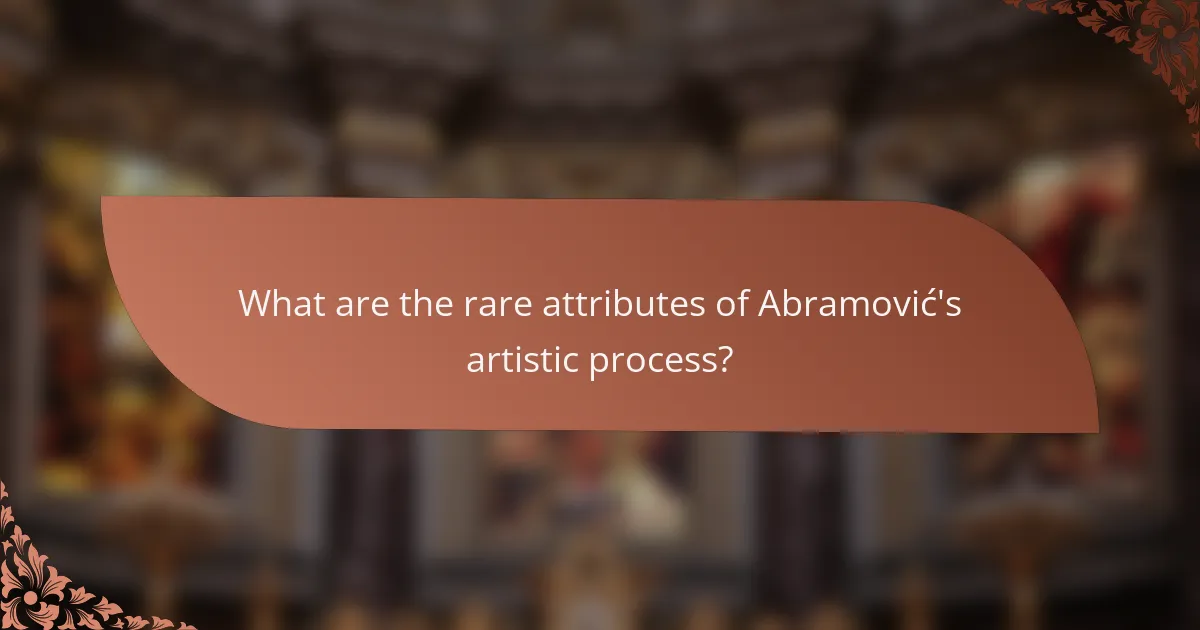
What are the rare attributes of Abramović’s artistic process?
Marina Abramović’s artistic process features rare attributes like extreme physical endurance, deep emotional vulnerability, and a profound connection with the audience. These elements create transformative experiences that challenge conventional boundaries of art. Abramović often employs unconventional materials, such as her own body, to explore themes of pain and endurance. Her unique approach to time, incorporating lengthy performance durations, also sets her apart in the performance art landscape.
How does she incorporate technology into her performances?
Marina Abramović incorporates technology into her performances through innovative tools and digital media. She uses video projections, live streaming, and interactive installations to enhance audience engagement. These technologies create immersive experiences that challenge traditional boundaries of performance art. For instance, her work “The Artist is Present” utilized live video feeds to connect with remote audiences, expanding the reach of her art. Additionally, she explores virtual reality to deepen emotional connections, pushing the limits of interaction between performer and viewer.
What makes her collaborative projects distinctive?
Marina Abramović’s collaborative projects are distinctive due to their emphasis on audience participation, emotional engagement, and the exploration of physical and psychological boundaries. Her works often blur the lines between performer and audience, creating a shared experience that challenges traditional art forms. For instance, “The Artist is Present” invited viewers to sit silently across from her, fostering deep connections and introspection. This unique approach transforms spectators into active participants, enhancing the overall impact of her performances. Additionally, her willingness to confront discomfort and vulnerability sets her projects apart, pushing the limits of what performance art can achieve.
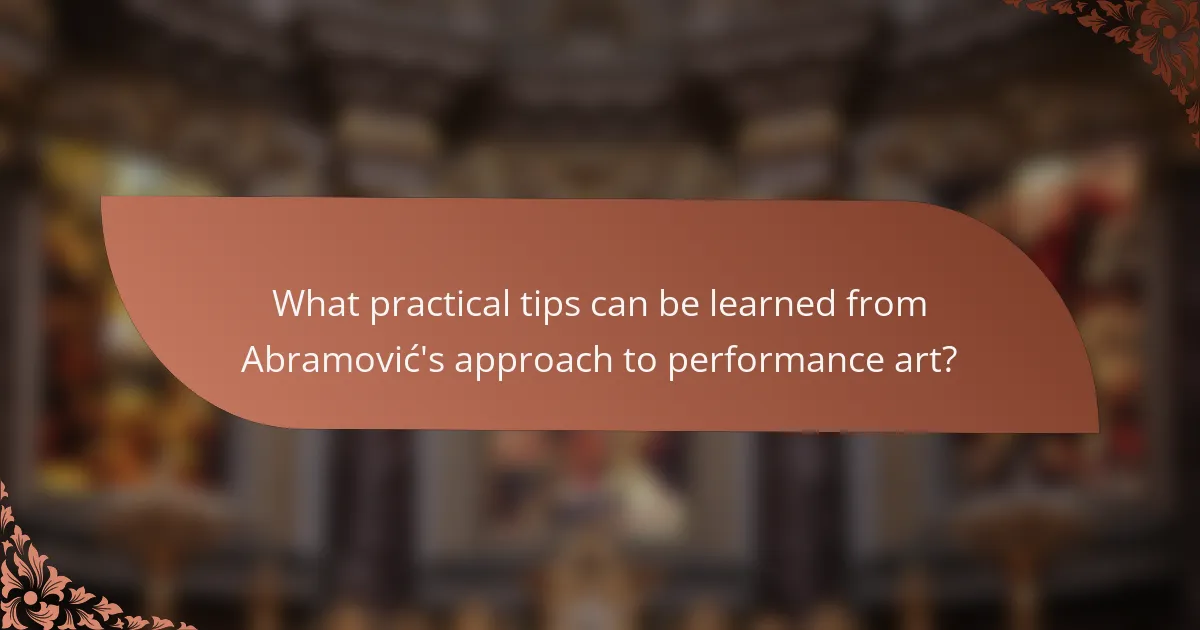
What practical tips can be learned from Abramović’s approach to performance art?
Marina Abramović’s approach to performance art teaches valuable lessons in audience engagement and emotional vulnerability. First, establish a deep connection with the audience by inviting their participation. This interaction fosters a shared experience that enhances the impact of the performance. Second, embrace discomfort and push boundaries to challenge both the performer and the audience. This exploration of limits creates a powerful dialogue about existence and perception. Finally, maintain authenticity throughout the performance, which resonates with viewers and leaves a lasting impression. These practical tips encourage artists to transform their work into a profound exploration of human connection.
How can artists effectively engage their audience?
Artists can effectively engage their audience by creating immersive experiences that invite participation. Marina Abramović exemplifies this through her performance art, which often blurs the boundaries between artist and audience. Her works encourage interaction, making the audience an integral part of the artistic expression. For instance, in “The Artist is Present,” she maintained prolonged eye contact with participants, fostering a deep emotional connection. This unique approach challenges traditional art forms and enhances audience involvement, demonstrating the power of vulnerability in performance art. Ultimately, artists can deepen engagement by prioritizing authentic interactions and shared experiences.
What strategies enhance the emotional impact of a performance?
Engaging the audience through emotional strategies enhances performance impact. Marina Abramović utilizes techniques like vulnerability, physical endurance, and direct eye contact. These methods foster a deep connection, provoking intense emotional responses. Additionally, the element of unpredictability in her performances keeps the audience engaged and introspective. By breaking boundaries and challenging comfort zones, she amplifies the emotional resonance of her art.
